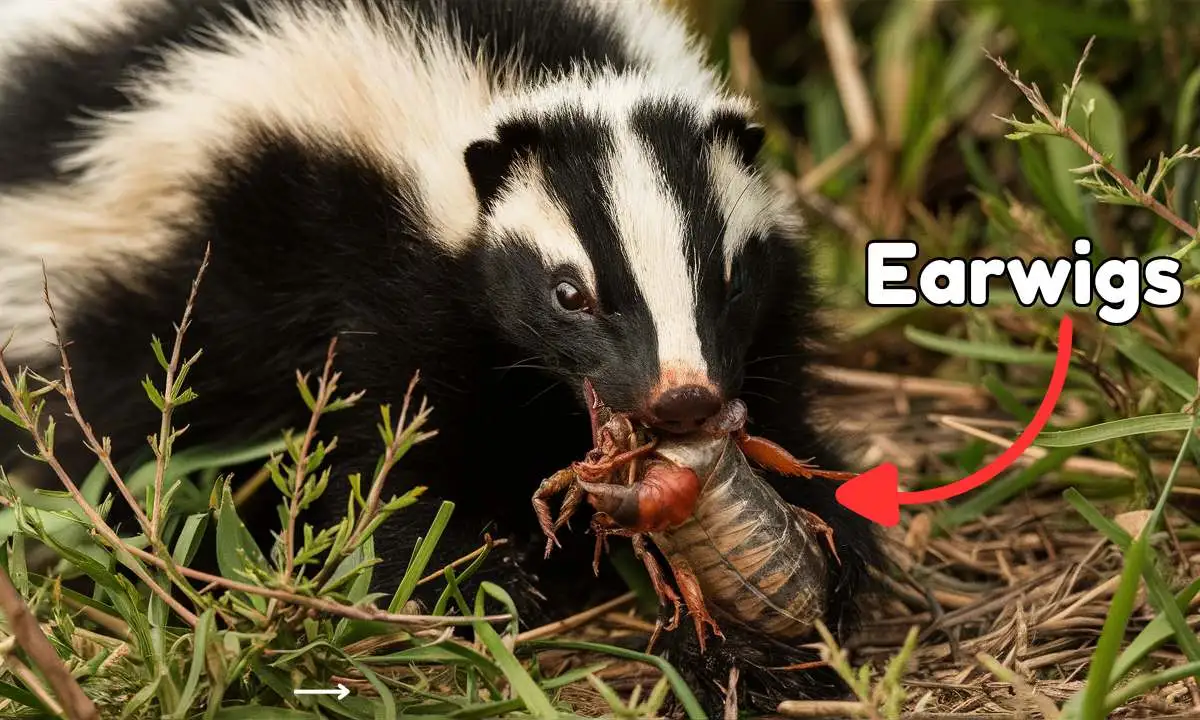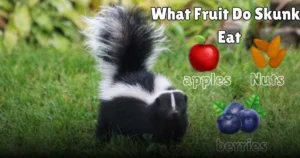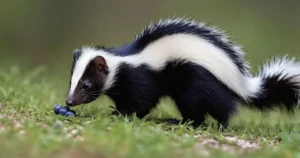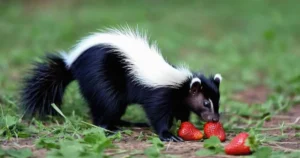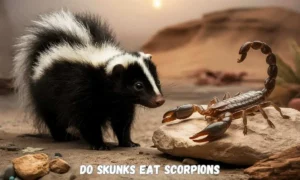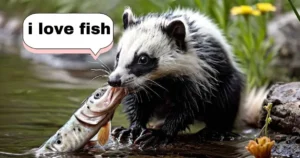Do Skunks Eat Earwigs?
Yes, skunks munch on earwigs as part of their diet! As a skunk pet owner and wildlife researcher, I’ve learned that these black and white critters eat all kinds of bugs, including earwigs. Skunks help keep gardens and farms free of pests and understanding their eating habits can help you manage their presence around your home.
Skunks: Opportunistic Feeders
Ever wonder what a skunk’s menu looks like? These striped creatures are known as opportunistic feeders, which means they eat just about anything they can find. Among the various items in their diet, skunks may chow down on earwigs. Yes, the tiny insects that sometimes take up residence in our gardens. Skunks, with their varied diet, contribute to controlling the population of such pests.
Variety In Skunk Diet
Skunks have a diverse palate that changes with the seasons. They munch on a mix of plants and animals. Here’s a glimpse into their diet:
- Insects like earwigs, beetles, and crickets
- Small mammals such as mice and voles
- Seasonal fruits and nuts
- Earthworms and grubs
- Bird eggs and nestlings when available
Skunks are not picky eaters. They keep gardens free of harmful bugs and rodents. This table shows what skunks eat in different seasons:
| Season | Main Food Source |
|---|---|
| Spring | Insects, worms, small rodents |
| Summer | Fruits, nuts, plants |
| Fall | Build up fat with proteins and carbs |
| Winter | They slow down, eat less |
Adaptability To Food Sources
Skunks are masters of adaptation when it comes to their diet. They thrive in various environments, from woodlands to urban areas. Their ability to adjust to available food sources is impressive. Here’s how they do it:
- Using their keen sense of smell to locate food underground
- Digging with strong claws to find grubs and insects
- Eating plants and berries when insects are scarce
- Storing fat in the fall to prepare for winter
Skunks’ feeding habits help control pest populations. This is beneficial to both humans and the ecosystem. They are nature’s pest control agents, offering a natural solution to insect infestations, including earwigs.
Earwigs: A Potential Prey For Skunks
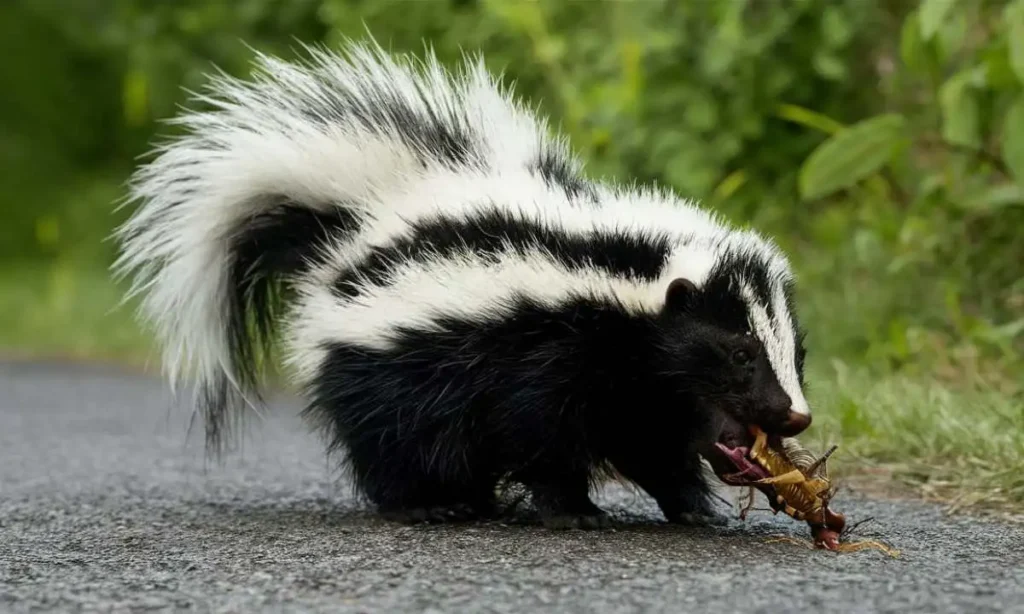
Many wonder about the diverse diet of skunks and whether it includes small insects. Among these insects, earwigs often spark curiosity. Earwigs: A Potential Prey for Skunks explores the likelihood of these nocturnal mammals feasting on these common garden dwellers. Skunks are known for their omnivorous diets, which could very well make earwigs a part of their menu.
Earwig Habitat And Behavior
Earwigs are small, brown insects recognized by their distinctive pincers. They thrive in moist environments and are active mostly at night. Understanding their habitat and behavior helps explain their interactions with skunks.
- Earwigs prefer dark and damp areas, such as under logs, rocks, and mulch.
- They consume plants and dead insects, contributing to the ecosystem’s nutrient cycle.
- During the day, earwigs hide to avoid predators and the sun.
Skunks, with their excellent digging abilities, often invade earwig hideouts. They use their keen sense of smell to locate these insects. Earwigs’ nocturnal habits also align with skunks’ active periods, increasing the chances of encounters between the two.
| Earwig Characteristic | Description |
|---|---|
| Habitat | Moist, dark areas like under debris and inside garden soil |
| Behavior | Nocturnal, hides during the day, scavenges at night |
| Diet | Plants, dead insects, and organic debris |
Earwigs As A Food Source
When it comes to diet, skunks are not picky. They will eat fruits, nuts, small rodents, and insects. This includes earwigs. Earwigs serve as a nutritious snack for skunks, packed with protein and easy to catch. Here’s why they are an ideal food source:
- Earwigs are abundant in many habitats that skunks inhabit.
- They are slow-moving, making them an easy target for skunks.
- Their nocturnal nature means they’re available when skunks are hunting.
Skunks rely on their sense of smell to find food buried in the ground or hidden under debris. Earwigs’ habit of hiding in soil and leaf litter makes them vulnerable to skunks’ foraging. With earwigs being a common presence in skunks’ environments, they undoubtedly become a part of the skunks’ varied diet.
Observations In The Wild
Many wonder if skunks eat earwigs during their foraging in the wild. Observations in nature provide insights. Researchers and wildlife enthusiasts have noticed interesting eating habits of skunks. They often search for food at night. This includes a variety of insects, among them potentially earwigs. Let’s dive into what studies say and how skunks behave while hunting for their meals.
Field Studies And Data
Several field studies have focused on the diet of skunks. These studies involve observing skunks in their natural habitats. Scientists track what skunks eat over different seasons. Findings suggest that skunks have a varied diet. It changes based on what’s available. Here’s what research shows about skunks and earwigs:
- Skunks eat both plants and animals.
- Insects are a significant part of their diet.
- Earwigs have been found in the stomach contents of some skunks.
This information comes from analyzing the stomach contents of skunks in different regions. A table summarizing the data might look like this:
| Season | Food Type | Percentage |
|---|---|---|
| Spring | Insects | 60% |
| Summer | Earwigs | 5% |
| Fall | Fruits | 20% |
| Winter | Small Rodents | 15% |
This table shows that while earwigs are not the main food source, they are indeed part of the diet in summer.
Behavioral Patterns Of Skunks
Understanding how skunks find and eat their food is fascinating. They have unique behaviors when it comes to foraging. Here’s what observations have shown:
- Skunks are mostly nocturnal, searching for food at night.
- They use their strong sense of smell to locate insects.
- Once they find earwigs, they use their front paws to dig them out.
Observations also suggest skunks have preferences. They tend to eat more insects, like earwigs, during the warmer months. This is likely because insects are more abundant then. Skunks adjust their diet based on availability, showing their adaptability.
Researchers have noted that skunks play an essential role in controlling insect populations. By eating earwigs and other insects, they help maintain a balance in the ecosystem. This behavior showcases the interconnectedness of species in the wild.
Predator-prey Relationship
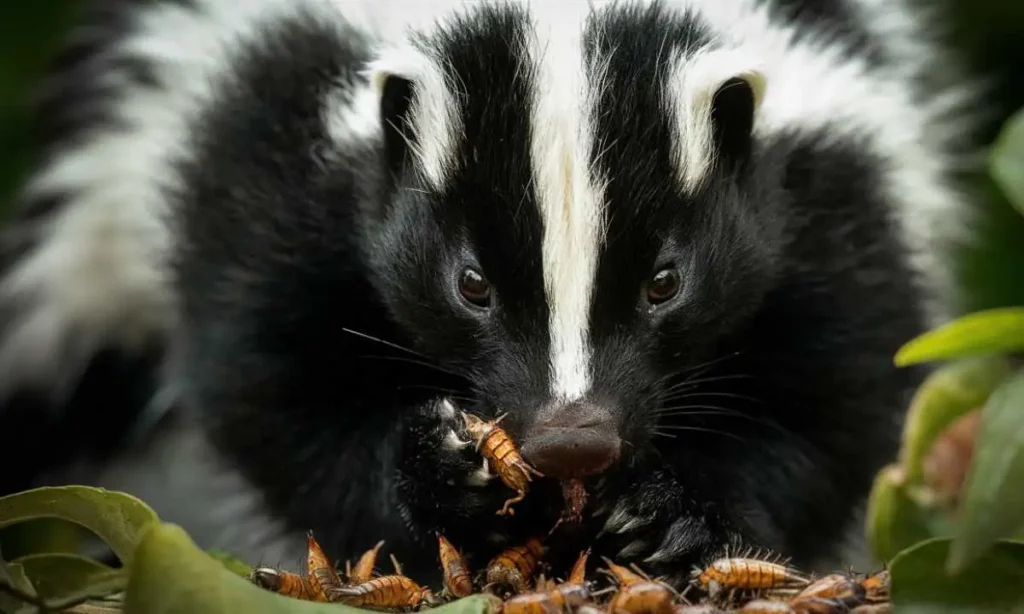
Imagine a garden at dusk. Skunks emerge, noses to the ground, searching for snacks. Among their potential feasts are earwigs, those pinchy little insects that dwell under rocks and logs. This is a classic example of a predator-prey relationship. In this dynamic, skunks act as predators while earwigs are the prey. Such interactions are vital for maintaining balance in ecosystems. They control populations and support biodiversity. Let’s explore how skunks impact earwig populations and their role in ecological balance.
Impact On Earwig Population
Earwigs make up part of the varied diet of skunks. When skunks hunt for earwigs, they influence the earwig population in several ways:
- Population Control: Skunks help keep earwig numbers in check. Without predators, earwig populations could explode, leading to issues such as crop damage.
- Preventing Overcrowding: By eating earwigs, skunks prevent overcrowding. This ensures that earwigs have enough resources to survive and reproduce at sustainable levels.
- Selective Pressure: Skunks may prey on specific earwig individuals, such as the slow or sick. This can lead to a healthier, more resilient earwig population over time.
Here’s a simple representation of what a skunk’s impact on earwigs might look like in a hypothetical garden:
| Without Skunk Predation | With Skunk Predation |
|---|---|
| Higher earwig population density | Lower earwig population density |
| Increased plant damage | Reduced plant damage |
| Potential for disease spread among earwigs | Healthier earwig population |
Eating earwigs is just one way skunks contribute to a balanced garden ecosystem.
Role In Ecological Balance
Skunks play a crucial role in maintaining ecological balance through their diet, which includes earwigs. This role can be understood in the following points:
- Diet Diversity: Skunks eat various pests, not just earwigs. This diversity helps to stabilize many insect populations.
- Seed Dispersal: As omnivores, skunks also consume fruits and nuts, aiding in seed dispersal and plant growth.
- Soil Aeration: While digging for earwigs and other prey, skunks aerate the soil. This improves soil health and benefits plant life.
Consider the wider impacts of skunks in an ecosystem:
| Aspect of Ecological Balance | Contribution of Skunks |
|---|---|
| Insect Population Regulation | Controls potential pest outbreaks |
| Soil Health | Enhances soil by aerating and mixing nutrients |
| Plant Growth | Spreads seeds, promoting new plant growth |
The presence of skunks in an ecosystem brings much-needed balance, showcasing nature’s interconnectedness.
Potential Benefits And Risks
Do skunks eat earwigs? This question sparks curiosity among wildlife enthusiasts and homeowners alike. Skunks are opportunistic feeders, which means they often snack on a variety of insects, including earwigs. While this might seem like a simple dietary choice, it’s important to explore the potential benefits and risks that come with earwigs as part of a skunk’s diet.
Benefits Of Earwig Consumption
Earwigs may seem like an unusual choice for a meal, but they offer several advantages to skunks. These insects are rich in protein, which is crucial for the growth and maintenance of body tissues. Plus, earwigs are abundant and easy to catch, making them an accessible food source. Here are some benefits:
- Protein-rich: Essential for skunk health and energy.
- Abundant: Earwigs reproduce quickly, ensuring a steady food supply.
- Easy to catch: Skunks can easily dig them out of their habitats.
Earwigs also contribute to a balanced ecosystem by breaking down plant material. When skunks consume earwigs, they help regulate the earwig population. This balance is vital for a healthy garden as it prevents overpopulation and the potential damage earwigs can cause to crops and flowers.
| Benefit | Description |
|---|---|
| Nutritional Value | High in protein, supports skunk health. |
| Ecosystem Balance | High in protein, it supports skunk health. |
| Accessibility | Earwigs are easy for skunks to find and eat. |
Potential Risks For Skunks
While earwigs offer nutritional benefits, there are also risks to consider. Skunks face potential dangers when they include these insects in their diet. Earwigs are often found near human dwellings, which could lead skunks into close encounters with people and pets. This proximity increases the chances of conflict and potential harm to the skunk. Here are some risks:
- Pesticides: Earwigs exposed to chemicals may pose a health risk to skunks.
- Parasites: Earwigs can carry parasites that might infect skunks.
- Human conflict: Searching for earwigs near homes could lead to dangerous encounters.
Additionally, skunks that heavily rely on earwigs might miss out on other vital nutrients found in a more varied diet. It’s essential for them to consume a mix of plants, fruits, and different insects to meet all their dietary needs. A table summarizing these risks is provided below:
| Risk | Description |
|---|---|
| Chemical Exposure | Consuming earwigs in pesticide-treated areas can be toxic. |
| Parasitic Infections | Earwigs may transfer harmful parasites to skunks. |
| Nutritional Imbalance | A diet limited to earwigs may lack diversity, leading to deficiencies. |
Conservation Implications
Do skunks eat earwigs? This question might seem peculiar, yet it holds weight in understanding our ecosystem’s complexity. Skunks, known for their notorious defense mechanism, contribute to the balance of nature by preying on various insects, including earwigs. Earwigs, on the other hand, play a role in decomposing plant material and are a food source for predators. Examining such food interactions is vital for conservation efforts, as it sheds light on the intricacies of food webs and the importance of each species within them.
Ecological Significance
Understanding the role of skunks in controlling earwig populations reveals the tapestry of ecological interactions. Here’s why this dynamic is significant:
- Pest control: Skunks help manage earwig numbers, naturally curbing potential overpopulation.
- Nutrient cycling: Earwigs decompose organic matter, enriching soil quality.
- Biodiversity: The predator-prey relationship between skunks and earwigs supports diverse ecosystems.
These interactions have a ripple effect, influencing plant health and the broader biological community. To illustrate:
| Species | Role | Impact |
|---|---|---|
| Skunks | Predator | Controls insect populations |
| Earwigs | Prey/Decomposer | Supports soil fertility; food for other wildlife |
Conservation Strategies
Preserving the balance between skunks and earwigs requires thoughtful strategies. Conservationists employ various techniques to ensure these species continue to thrive:
- Habitat protection: Safeguarding environments where skunks and earwigs live is crucial.
- Research: Studying their habits and impacts leads to informed actions.
- Public education: Teaching communities about these creatures promotes coexistence.
Effective strategies might include:
| Action | Purpose | Expected Outcome |
|---|---|---|
| Natural habitats conservation | Provide safe living spaces | Sustainable populations of skunks and earwigs |
| Environmentally friendly pest control | Reduce chemical use | Healthier ecosystems |
| Community engagement | Raise awareness | Support for conservation efforts |
Frequently Asked Questions
Skunks primarily eat insects such as beetles, crickets, grasshoppers, bees, and larvae. Their diet also includes various grubs and worms.
Skunks primarily enjoy a diet of insects, fruits, and small rodents. They often seek out larvae and grubs, making gardens a favorite foraging spot. Berries and fallen fruit also attract these nocturnal creatures. Their varied diet reflects their adaptability in both urban and wild environments.
Skunks forage at night, eating insects, grubs, small rodents, fruits, nuts, and plants. Their omnivorous diet is diverse and season-dependent.
Conclusion
Wrapping up, it’s clear that skunks have a varied diet, including earwigs. This insight sheds light on the fascinating world of skunk eating habits. Remember, understanding these creatures helps us coexist peacefully. So, next time you spot a skunk, you might just know what it’s searching for.

